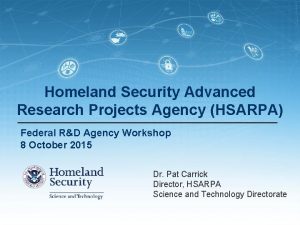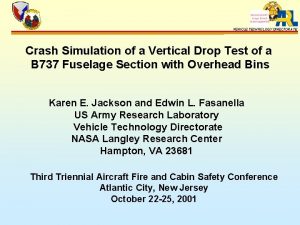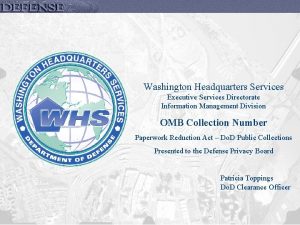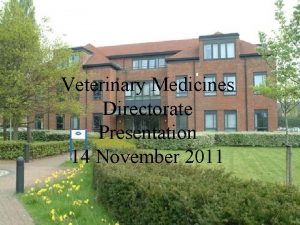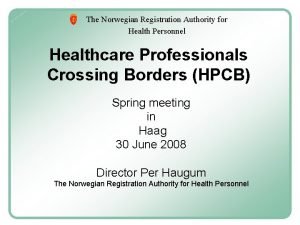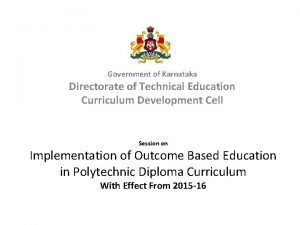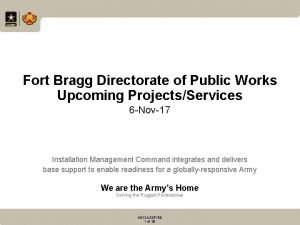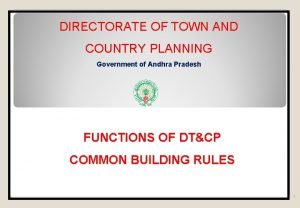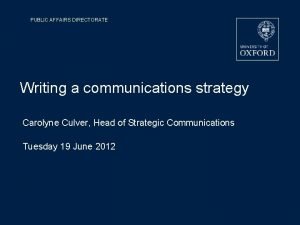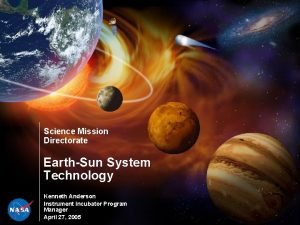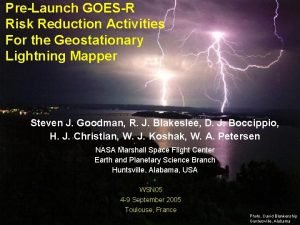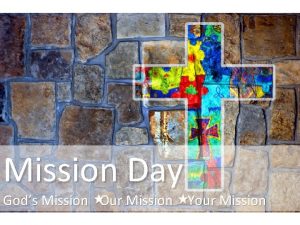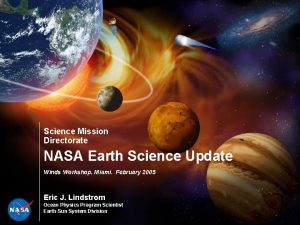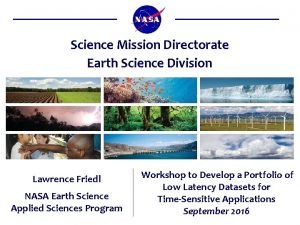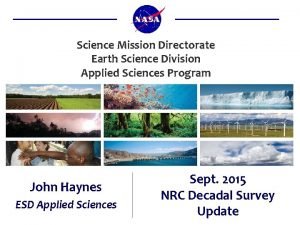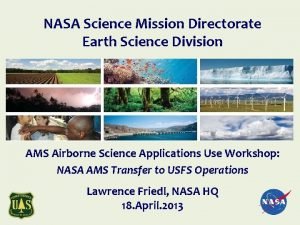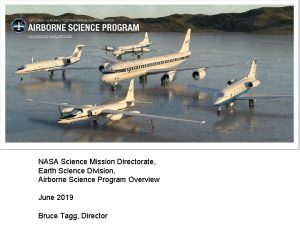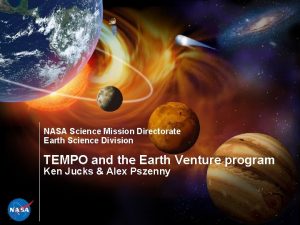Science Mission Directorate EarthSun System Technology Kenneth Anderson












- Slides: 12

Science Mission Directorate Earth-Sun System Technology Kenneth Anderson Instrument Incubator Program Manager April 27, 2005

Approach to Technology Development • The Earth Science Biennial Review (June 1997) recommended that future missions be implemented with shorter development time and using the best suitable technology. • The resulting plan included the establishment of a flexible, science-driven technology strategy that would develop very specific technologies via a competitive selection process and provide a broad portfolio of emerging technologies for infusion into a range of Earth Science missions. • To meet these challenges the Earth Science Technology Program was established and the Earth Science Technology Office (ESTO) created in March 1998. • Transformation of Space and Earth Science Enterprises to Science Mission Directorate in August 2004 merged Earth Science with Sun-Earth Connection into the Earth-Sun System Division. The Earth-Sun System Technology Office (ESTO): • • • Performs strategic technology planning for Earth Science and the Sun-Earth Connection Coordinates with other NASA Mission Directorates and participating Agencies Implements focused technology development for the Earth-Sun System Division http: //esto. nasa. gov/ 2

Technology Development Approach “Old” Paradigm Technology derived from Missions Enterprise Objectives Missions Technology Program “New” Paradigm Missions enabled by Technology` Enterprise Objectives Technology Program Missions Enterprise objectives established Missions sets derived from Enterprise objectives Technology programs derived From mission requirements 3 Enterprise objectives drive technology Technology expands mission horizons Missions evolve from convergence of objectives and technology

Science Focus Areas Atmospheric Composition Water & Energy Cycle Weather Climate Variability & Change 4 Earth Surface & Interior Structure Carbon Cycle & Ecosystems

Planning & Setting Direction • Science needs taken from science roadmaps + open community workshops • Coordinate scope of all solicitations with science leads to narrow scope http: //esto. nasa. gov/estips 5 Earth Science Technology Integrated Planning System (ESTIPS)

Implementation - Program Elements Advanced Technology Initiatives (ATI)—provides for concept studies and development of component and subsystems technologies for instruments and platforms Instrument Incubator Program (IIP)—provides new instrument and measurement techniques including lab development and airborne validation Advanced Information Systems Technologies (AIST)—provides innovative onorbit and ground capabilities for the communication, processing, and management of remotely sensed data and the efficient generation of information Computational Technologies (CT)—provides techniques and systems that enable high performance throughput, archiving, data manipulation, and visualization of very large, highly distributed remotely sensed data sets consistent with modeling needs 6

Technology Program Readiness Levels s d gn lly y el. n le rte i f i d g d s p l e i o o pp e a e e nta si p t c p p l e M u D y A t a es in Re l me D d ty Q g r e c o a l i T o t al n ac P & i t o e t i u a i t d o r t t n t r u c ro d io Cr nen Pr ste ee Sp si ed t ep xpe pt ula P e n a a c e e p r Te n E B erv gi d in er lo po nc orm P o n d p e o s C te F E te O b C om ev s s O C e e D T T 0 1 2 3 4 5 6 7 8 Advanced Concepts Advanced Technology Initiative (ATI) Instrument Incubator Program (IIP) Advanced Information Systems Technology (AIST) Computational Technology (CT) Small Bus. Innov. Research (SBIR) Exploration Systems Res & Tech (ESR&T) Science & Appl. Measurement 9

Technology Investments (FY 04 -05) GSFC (31) JPL (29) Instruments Info Systems CT Platforms 12 6 10 1 Instruments Info Systems CT Studies Federal Labs (7) 18 4 8 1 Instruments Info Systems 12 1 8 1 Info Systems ESTO Small Corp. (13) Ball Aerospace (Instruments - 2) Draper Labs (Info Systems - 1) ITT Industries (Info Systems - 1) Lockheed Martin (Info Systems - 1) Info Systems ARC (2) Aerospace Corp. (Instruments - 1) Air Force Research Lab (Instruments - 1; Info Sys - 1) Lawrence Berkeley NL (CT - 1) NCAR (Info Sys 2; CT - 1) Large Corp. (5) Instruments: 60 Info Systems: 29 Comp. Tech. : 28 Platforms: 1 Studies: 1 Total: 119 GRC (1) La. RC (13) Aerodyne Research (Instru. - 1) ASRC Aerospace Corp. (Instru. - 1) AER Inc. (Info Systems - 1) Barr Associates, Inc (Instruments - 1) BBN Technologies (Info Systems - 1) GST (CT - 2) Lite Cycles, Inc. (Instruments - 1) Polatomic (Instruments - 1) Q-Peak, Inc. (Instruments - 1) Qor. Tek Inc (Instruments - 1) SES, Inc. (Instruments - 1) Spectrum Astro (Info Systems - 1) 2 Academia (18) Cal Institute of Tech (CT - 1) Carnegie Mellon (Info Systems - 1) George Mason U. (Info Systems - 1) Georgia Tech (Instruments - 1) Harvard Univ. (Instruments - 1) MIT (CT - 1) Ohio State Univ. (Instruments - 1) U. of Alaska (Info Systems - 1) U. of California, Los Angeles (CT - 1) U. of Colorado, Boulder (Instruments - 2) U. of Illinois at Urbana-Champaign (Info Sys - 1; CT - 1) U. of Maryland (CT - 1) U. of Michigan (Instruments - 1; CT - 1) U. of Oklahoma (Info Systems - 1) USC/ISI (Info Systems - 1)

Instrument Incubator Program Overview • The objectives of the IIP are to identify, develop and, where appropriate demonstrate new measurement technologies which: • Reduce the risk, cost, size, and development time of Earth observing instruments, and • Enable new Earth observation measurements. • IIP designed to reduce risk of new, innovative instrument systems so they can be successfully used in science AO in a 3 year acquisition environment. • TRL guidance • Entry TRL from 3 to 5; Exit TRL less than or equal to 6. • Development must advance by at least one TRL. • The results at the exit point should provide convincing evidence that the instrumentation can make the proposed measurements and that an operational instrument can be built within the context of the new shorter acquisition cycles. • Solicits: • Instrument design • Engineering model construction • Lab and/or field demonstrations • Proposer defines starting and exit points Three year development, second and third years as options. • Award values in range of $500 K to $1000 K annually 9

Instrument Incubator NRA - 2004 • Solicitation released August 19; 82 responses received November 2. Academia Industry NASA Centers FFRDCs (inc. JPL) Other 22 proposals 18 proposals 26 proposals 12 proposals 4 proposals (27%) (22%) (32%) (15%) (5%) • Based upon prioritized science topics • Three Primary Science Focus areas: • Atmospheric aerosols and trace gases, especially in the lower troposphere • Ice Topographic Mapping • Tropospheric Winds • Other instrument proposals also allowed • Selections expected by end of April 10

UAV-SAR • UAV-SAR is a program to develop an L-band, repeat-pass interferometric SAR • • • Initial operation will be on a Gulfstream GIII, with later transition to a UAV • • • 11 PI: Dr. Scott Hensley, JPL Heritage from AIRSAR and GEOSAR programs Will address a range of science investigations, with primary emphasis on solid earth science System design includes extendability to additional frequencies/single pass interferometry Transition plan in development Instrument PDR was successfully held on April 12 -14 at JPL CDR planned for fall, 2005 First engineering test flights of system planned for late 2006, with science qualification flights in 2007 Final delivery estimated for fourth quarter FY 2008

2005 ROSES Solicitation • The Advanced Component Technology (ACT-05) NRA was released on January 28, 2005 as part of the ROSES solicitation. • The NRA emphasizes six target areas: • active and passive microwave antennas for Earth Science Instruments, • active and passive electronics for Earth Science Instruments, and • in situ and remote sensing instrument technologies that are highly sought by the Sun-Solar System Connection Science Program. • Ninety-six potential proposers from NASA, academia, private industry and other government agencies are planning to respond to the call for component technologies and subsystems sought in the NRA. • Proposals are due on April 28, 2005. 12
 Hsarpa
Hsarpa Vehicle technology directorate
Vehicle technology directorate Sciencefusion think central
Sciencefusion think central What is your favourite subject?
What is your favourite subject? Executive services directorate
Executive services directorate Veterinary medicines directorate
Veterinary medicines directorate Norwegian registration authority for health personnel
Norwegian registration authority for health personnel Early childhood education and care directorate
Early childhood education and care directorate Credilab
Credilab Dpw fort bragg
Dpw fort bragg Directorate of town & country planning
Directorate of town & country planning European directorate for the quality of medicines
European directorate for the quality of medicines Public affairs directorate oxford
Public affairs directorate oxford
